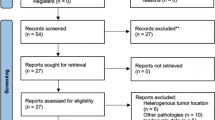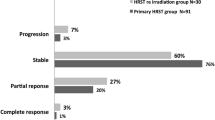Abstract
Purpose
Hypofractionated stereotactic radiotherapy (HSRT) for refractory Cushing’s disease may offer a condensed treatment schedule for patients with large tumors abutting the optic chiasm unsuitable for stereotactic radiosurgery (SRS). To-date only four patients have been treated by HSRT in the published literature. We investigated the feasibility, toxicity, and efficacy of HSRT compared to SRS.
Methods
After approval, we retrospectively evaluated patients treated at our institution for refractory Cushing’s disease with SRS or HSRT. Study outcomes included biochemical control, time to biochemical control, local control, and late complications. Binary logistic regression and Cox proportional hazards regression evaluated predictors of outcomes.
Results
Patients treated with SRS (n = 9) and HSRT (n = 9) were enrolled with median follow-up of 3.4 years. Clinicopathologic details were balanced between the cohorts. Local control was 100% in both cohorts. Time to biochemical control was 6.6. and 9.5 months in the SRS and HSRT cohorts, respectively (p = 0.6258). Two patients in each cohort required salvage bilateral adrenalectomy. Late complications including secondary malignancy, radionecrosis, cranial nerve neuropathy, and optic pathway injury were minimal for either cohort.
Conclusions
HSRT is an appropriate treatment approach for refractory Cushing’s disease, particularly for patients with large tumors abutting the optic apparatus. Prospective studies are needed to validate these findings and identify factors suggesting optimal fractionation approaches.


Similar content being viewed by others
References
Cushing H (1932) The basophil adenomas of the pituitary body and their clinical manifestations (pituitary basophilism). Bull Johns Hopkins Hosp 50:137–195
Cushing H (1932) Further notes on pituitary basophilism. JAMA 99:281–284
Buliman A, Tataranu L, Paun D et al (2016) Cushing’s disease: a multidisciplinary overview of the clinical features, diagnosis, and treatment. J Med Life 9:12–18
Broder MS, Neary MP, Chang E et al (2015) Incidence of Cushing’s syndrome and Cushing’s disease in commercially-insured patients %3c65 years old in the United States. Pituitary 18:283–289. https://doi.org/10.1007/s11102-014-0569-6
Dahia PLM, Grossman AB (1999) The molecular pathogenesis of corticotroph tumors. Endocr Rev 20:136–155. https://doi.org/10.1210/edrv.20.2.0358
Newell-Price J, Bertagna X, Grossman AB, Nieman LK (2006) Cushing’s syndrome. Lancet 367:1605–1617. https://doi.org/10.1016/S0140-6736(06)68699-6
Pivonello R, De Leo M, Cozzolino A, Colao A (2015) The treatment of cushing’s disease. Endocr Rev 36:385–486. https://doi.org/10.1210/er.2013-1048
Pivonello R, De Martino M, De Leo M et al (2008) Cushing’s syndrome. Endocrinol Metab Clin North Am 37:135–149. https://doi.org/10.1016/j.ecl.2007.10.010
Feelders RA, Pulgar SJ, Kempel A, Pereira AM (2012) The burden of Cushing’s disease: clinical and health-related quality of life aspects. Eur J Endocrinol 167:311–326. https://doi.org/10.1530/EJE-11-1095
Graversen D, Vestergaard P, Stochholm K et al (2012) Mortality in Cushing’s syndrome: a systematic review and meta-analysis. Eur J Intern Med 23:278–282. https://doi.org/10.1016/j.ejim.2011.10.013
Clayton RN (2010) Mortality in Cushing’s disease. Neuroendocrinology 92(Suppl 1):71–76. https://doi.org/10.4183/aeb.2010.83
Miller JW, Crapo L (1993) The medical treatment of cushing’s syndrome. Endocr Rev 14:443–458. https://doi.org/10.1210/edrv-14-4-443
Juszczak A, Ertorer ME, Grossman A (2013) The therapy of cushing’s disease in adults and children: an update. Horm Metab Res 45:109–117. https://doi.org/10.1055/s-0032-1330009
Mehta GU, Lonser RR, Oldfield EH (2012) The history of pituitary surgery for Cushing disease. J Neurosurg 116:261–268. https://doi.org/10.3171/2011.8.jns102005
Loeffler JS, Shih HA (2011) Radiation therapy in the management of pituitary adenomas [Review]. J Clin Endocrinol Metab 96:1992–2003. https://doi.org/https://dx.doi.org/10.1210/jc.2011-0251
Kong DS, Il Lee J, Do HL et al (2007) The efficacy of fractionated radiotherapy and stereotactic radiosurgery for pituitary adenomas: long-term results of 125 consecutive patients treated in a single institution. Cancer 110:854–860. https://doi.org/10.1002/cncr.22860
Mitsumori M, Shrieve DC, Alexander E et al (1998) Initial clinical results of linac-based stereotactic radiosurgery and stereotactic radiotherapy for pituitary adenomas. Int J Radiat Oncol Biol Phys 42:573–580. https://doi.org/10.1016/S0360-3016(98)00256-9
Fowler JF (2010) 21 Years of biologically effective dose. Br J Radiol 83:554–568. https://doi.org/10.1259/bjr/31372149
Pham CJ, Chang SD, Gibbs IC et al (2004) Preliminary visual field preservation after staged CyberKnife radiosurgery for perioptic lesions. Neurosurgery 54:799–810. https://doi.org/10.1227/01.NEU.0000114261.18723.6A
Adler JR, Gibbs IC, Puataweepong P, Chang SD (2006) Visual field preservation after multisession CyberKnife radiosurgery for perioptic lesions. Neurosurgery 59:2442–2454. https://doi.org/10.1227/01.NEU.0000223512.09115.3E
Liao HI, Wang CC, Wei KC et al (2014) Fractionated stereotactic radiosurgery using the Novalis system for the management of pituitary adenomas close to the optic apparatus. J Clin Neurosci 21:111–115. https://doi.org/10.1016/j.jocn.2013.03.024
Niranjan A, Flickinger JC (2008) Radiobiology, principle and technique of radiosurgery. Prog Neurol Surg 21:32–42. https://doi.org/10.1159/000156557
Kondziolka D, Shin SM, Brunswick A et al (2015) The biology of radiosurgery and its clinical applications for brain tumors. Neuro Oncol 17:29–44. https://doi.org/10.1093/neuonc/nou284
Hall EJ, Brenner DJ (1993) The radiobiology of radiosurgery: rationale for different treatment regimes for AVMs and malignancies. Int J Radiat Oncol Biol Phys 25:381–385. https://doi.org/10.1016/0360-3016(93)90367-5
Harris PA, Taylor R, Thielke R et al (2009) Research electronic data capture (REDCap)-a metadata-driven methodology and workflow process for providing translational research informatics support. J Biomed Inf 42:377–381. https://doi.org/10.1016/j.jbi.2008.08.010
Cahan W, Woodard H (1948) Sarcoma arising in irradiated bone; report of 11 cases. Cancer 1:3–29
Sonino N, Zielezny M, Fava GA et al (1996) Risk factors and long-term outcome in pituitary-dependent Cushing’s disease. J Clin Endocrinol Metab 81:2647–2652. https://doi.org/10.1210/jc.81.7.2647
Howlett T, Plowman P, Wass J et al (1989) Megavoltage pituitary irradiation in the management of Cushing’s disease and Nelson’s syndrome: long-term follow-up. Clin Endocrinol 31:309–323
Vicente A, Estrada J, de la Cuerda C et al (2009) Results of external pituitary irradiation after unsuccessful transsphenoidal surgery in Cushing’s disease. Acta Endocrinol (Copenh) 125:470–474. https://doi.org/10.1530/acta.0.1250470
Tran LM, Blount L, Horton D et al (1991) Radiation therapy of pituitary tumors: results in 95 cases. Am J Clin Oncol 14:25–29. https://doi.org/10.1097/00000421-199102000-00005
Zierhut D, Flentje M, Adolph J et al (1995) External radiotherapy of pituitary adenomas. Int J Radiat Oncol Biol Phys 33:307–314. https://doi.org/10.1016/0360-3016(95)00071-6
Estrada J, Boronat M, Mielgo M et al (1997) The long-term outcome of pituitary irradiation after unsuccessful transsphenoidal surgery in cushing’s disease. N Engl J Med 336:172–177. https://doi.org/10.1056/nejm199701163360303
Minniti G, Osti M, Jaffrain-Rea ML et al (2007) Long-term follow-up results of postoperative radiation therapy for Cushing’s disease. J Neurooncol 84:79–84. https://doi.org/10.1007/s11060-007-9344-0
Voges J, Kocher M, Runge M et al (2006) Linear accelerator radiosurgery for pituitary macroadenomas: a 7-year follow-up study. Cancer 107:1355–1364. https://doi.org/10.1002/cncr.22128
Sheehan JP, Pouratian N, Steiner L et al (2011) Gamma knife surgery for pituitary adenomas: factors related to radiological and endocrine outcomes. J Neurosurg 114:303–309. https://doi.org/10.3171/2010.5.jns091635
Castinetti F, Nagai M, Morange I et al (2009) Long-term results of stereotactic radiosurgery in secretory pituitary adenomas. J Clin Endocrinol Metab 94:3400–3407. https://doi.org/10.1210/jc.2008-2772
Devin JK, Allen GS, Cmelak AJ et al (2004) The efficacy of linear accelerator radiosurgery in the management of patients with Cushing’s disease. Stereotact Funct Neurosurg 82:254–262. https://doi.org/10.1159/000083476
Jagannathan J, Sheehan J, Pouratian N et al (2007) Gamma knife surgery for Cushing’s disease. J Neurosurg 106:980–987. https://doi.org/10.3171/jns.2007.106.6.980
Acknowledgements
This work was supported by CTSA Award No. UL1TR000445 from the National Center for Advancing Translational Sciences. Its contents are solely the responsibility of the authors and do not necessarily represent official views of the National Center for Advancing Translational Sciences or the National Institutes of Health.
Funding
There was no funding associated with this study.
Author information
Authors and Affiliations
Corresponding author
Ethics declarations
Conflict of interest
Alexander Sherry declares that he has no conflicts of interest. Mohamed H. Khattab receives research funding support from Varian Medical Systems and Brainlab, Inc. Mark Xu declares that he has no conflicts of interest. Patrick Kelly declares that he has no conflicts of interest. Joshua Anderson declares that he has no conflicts of interest. Guozhen Luo declares that she has no conflicts of interest. Andrea Utz declares that she has no conflicts of interest. Lola Chambless declares that she has no conflicts of interest. Anthony Cmelak declares that he has no conflicts of interest. Albert Attia receives funding from Brainlab, AstraZeneca, and Novocure.
Ethical approval
All procedures performed in studies involving human participants were in accordance with the ethical standards of the institutional and/or national research committee and with the 1964 Helsinki declaration and its later amendments or comparable ethical standards.
Informed consent
Informed consent was waived by the IRB due to the determination of minimal risk of the study.
Additional information
Publisher's Note
Springer Nature remains neutral with regard to jurisdictional claims in published maps and institutional affiliations.
Rights and permissions
About this article
Cite this article
Sherry, A.D., Khattab, M.H., Xu, M.C. et al. Outcomes of stereotactic radiosurgery and hypofractionated stereotactic radiotherapy for refractory Cushing’s disease. Pituitary 22, 607–613 (2019). https://doi.org/10.1007/s11102-019-00992-6
Published:
Issue Date:
DOI: https://doi.org/10.1007/s11102-019-00992-6




